Are you tired of fighting acne that won’t go away? The answer might be in your kitchen. Try these DIY face masks to tackle acne and get lasting results.
Key Takeaways
- Discover the different types of acne and their common triggers
- Learn how natural ingredients can effectively treat acne without harsh chemicals
- Explore cost-effective, customizable DIY face mask recipes for your unique skin needs
- Understand the benefits of homemade face masks for your skin’s health and the environment
- Gain insights on safe application and follow-up steps to enhance the efficacy of DIY masks
Understanding Acne: Types and Causes
Acne is a common skin issue that affects people of all ages, not just teens. It can last well into adulthood. Knowing the different types of acne and their causes is key to finding the right treatment.
Different Types of Acne Breakouts
Acne falls into two main types: non-inflammatory and inflammatory. Non-inflammatory acne includes whiteheads and blackheads. Inflammatory acne includes pustules, papules, nodules, and cystic acne.
Cystic acne is a severe form with large, painful bumps. Nodules can cause connected breakouts, making them hard to treat. Papules are moderate acne that can get worse. Pustules are pimples with pus.
Common Triggers for Acne Formation
Acne often starts with hormonal changes that make too much sebum. This oil, along with dead skin cells and bacteria, clogs pores. Stress, diet, environment, and some medicines can also cause acne.
Role of Natural Remedies in Acne Treatment
Natural remedies can help with mild to moderate acne. Ingredients like pimple treatments, oily skin care, and acne-fighting ingredients can reduce inflammation and fight bacteria. They help unclog pores for a more natural approach to managing acne.
Remember, everyone’s skin is different, and treatments work differently for everyone. Always talk to a dermatologist to find the best treatment for your skin.
Essential Ingredients for Natural Acne Treatment
Looking for natural ways to fight acne? Certain ingredients are key for tackling breakouts. These include anti-inflammatory masks and blemish control solutions. They aim to clear your skin and make it healthier.
Honey is a top choice for its antibacterial powers. It keeps bad bacteria away and soothes redness. Turmeric is also great, thanks to its ability to reduce inflammation.
Tea tree oil is a natural fighter against acne-causing bacteria. Clay helps by pulling out dirt and oil. Witch hazel tightens pores and controls oil.
Aloe vera and green tea soothe and protect your skin. Oatmeal helps calm down angry skin.
Using these ingredients, you can make custom, bespoke face masks for your skin. Mixing them right can make your skin clearer and brighter.
| Ingredient | Benefit |
|---|---|
| Honey | Antibacterial, anti-inflammatory |
| Turmeric | Anti-inflammatory, antimicrobial |
| Tea Tree Oil | Antimicrobial, pore-purifying |
| Clay | Oil-absorbing, deep cleansing |
| Witch Hazel | Astringent, sebum-regulating |
| Aloe Vera | Soothing, antioxidant-rich |
| Green Tea | Antioxidant, anti-inflammatory |
| Oatmeal | Anti-inflammatory, calming |
Adding these natural acne masks to your routine can help fight breakouts. Try different mixes to find what works best for you.
Benefits of Homemade Face Masks for Problematic Skin
Homemade face masks are a natural and affordable way to fight acne. They are cheaper than store-bought products and let you pick the ingredients. This makes them a gentle and effective way to care for your skin.
Cost-Effectiveness of DIY Solutions
Making your own face masks can save you a lot of money. You can use simple, cheap ingredients to make treatments that meet your skin’s needs. This way, you can take care of your skin without spending a lot.
Customization Options for Different Skin Types
Homemade face masks are great because you can make them fit your skin type. Whether your skin is oily, dry, sensitive, or prone to acne, you can choose the right ingredients. This helps you get the best results for your skin.
Environmental Benefits of Natural Ingredients
Using natural ingredients in your face masks is good for the planet. It helps avoid harsh chemicals found in many products. Natural ingredients from plants can nourish and refresh your skin in a safe way.
| Ingredient | Benefit |
|---|---|
| Honey | Antimicrobial, anti-inflammatory, and moisturizing properties |
| Turmeric | Potent antioxidant and anti-inflammatory effects |
| Clay | Deep cleansing, oil-absorbing, and pore-refining abilities |
| Aloe Vera | Soothing, hydrating, and healing properties for sensitive skin |
By using natural ingredients in your face masks, you can fight acne and get healthier skin. You’ll also enjoy the benefits of saving money and customizing your treatments.
DIY Face Masks for Acne: Basic Guidelines and Preparation
Making your own face masks at home can change the game in fighting acne. Before you start, it’s key to follow some basic steps. This ensures the best results and avoids skin irritation.
First, make sure your face is clean. Wash it well to get rid of dirt, oil, and other stuff that might mess with the mask’s work. A gentle steam can open pores, letting the mask’s ingredients get in deeper. But, be careful if you have rosacea or severe acne.
Then, mix your mask ingredients in a clean container. Be careful with new ingredients and do a patch test first. This checks for any skin reactions or sensitivities.
- Put the mask on clean, dry skin, but skip the eye area.
- Leave it on for 10 to 30 minutes, letting the ingredients do their job.
- Wash it off with warm water, then pat dry.
- End with a gentle, non-comedogenic moisturizer to keep your skin hydrated and nourished.
By following these steps, you can harness the power of natural ingredients. You’ll make DIY face masks that fit your skin’s needs. This helps prevent acne and brings out a radiant, healthy glow.
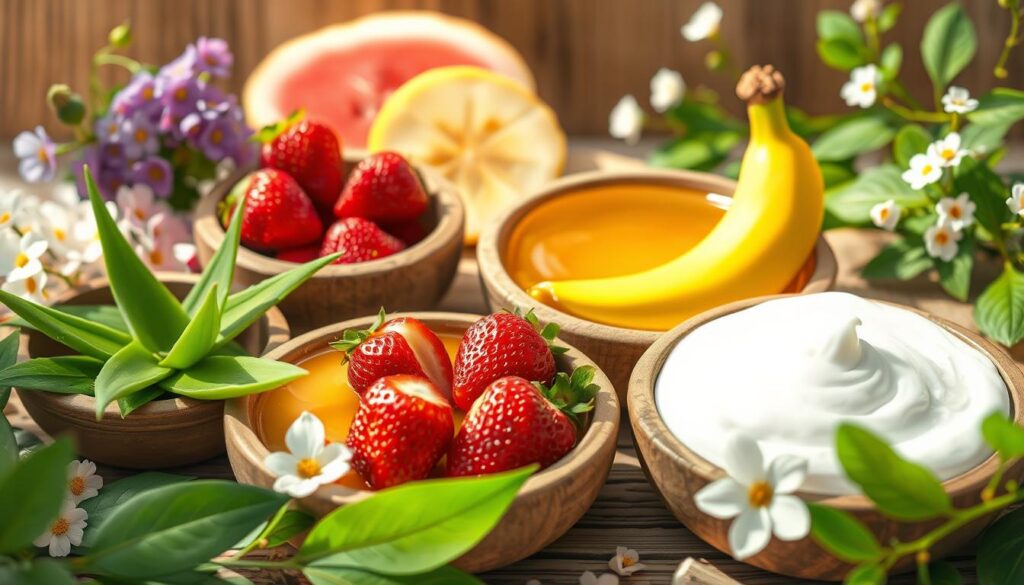
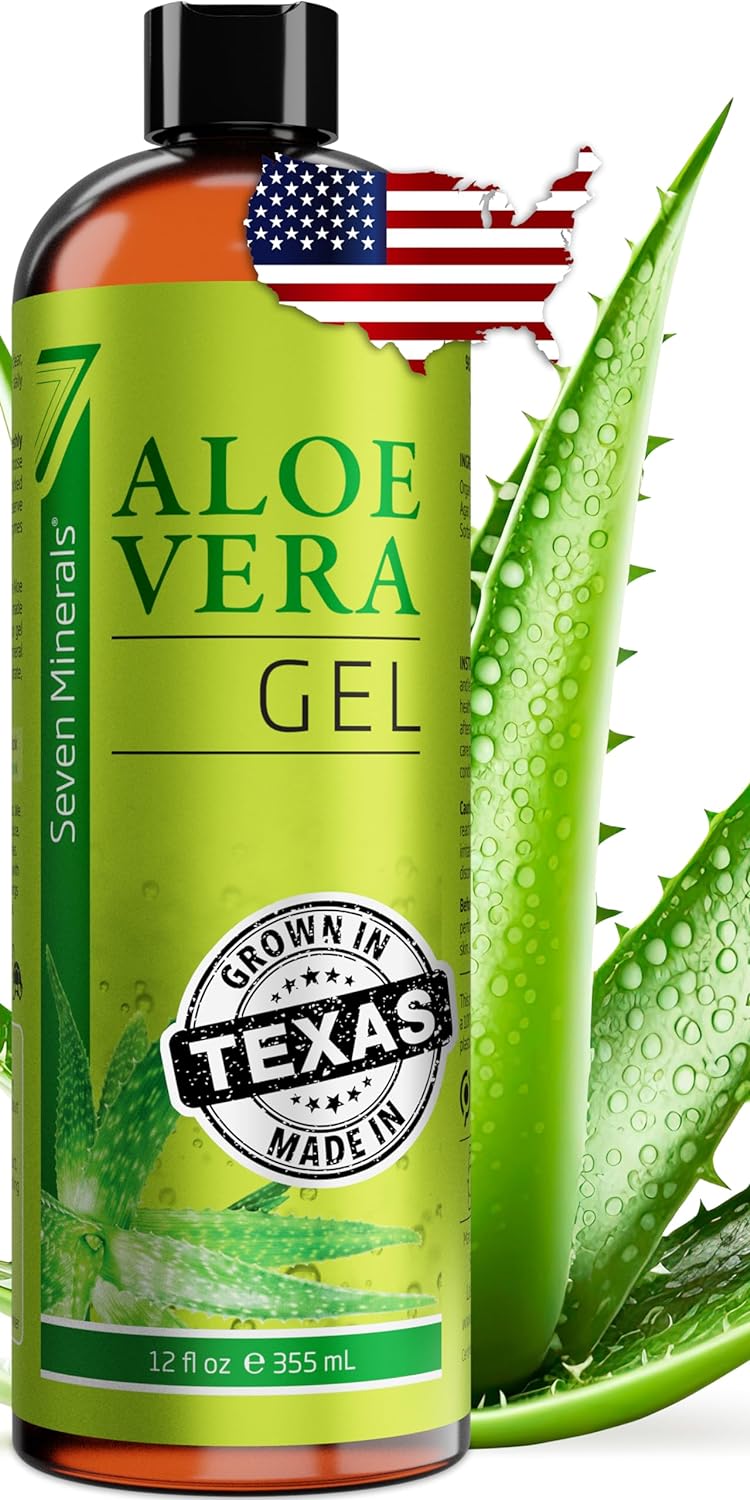
Aloe Vera Face Mask
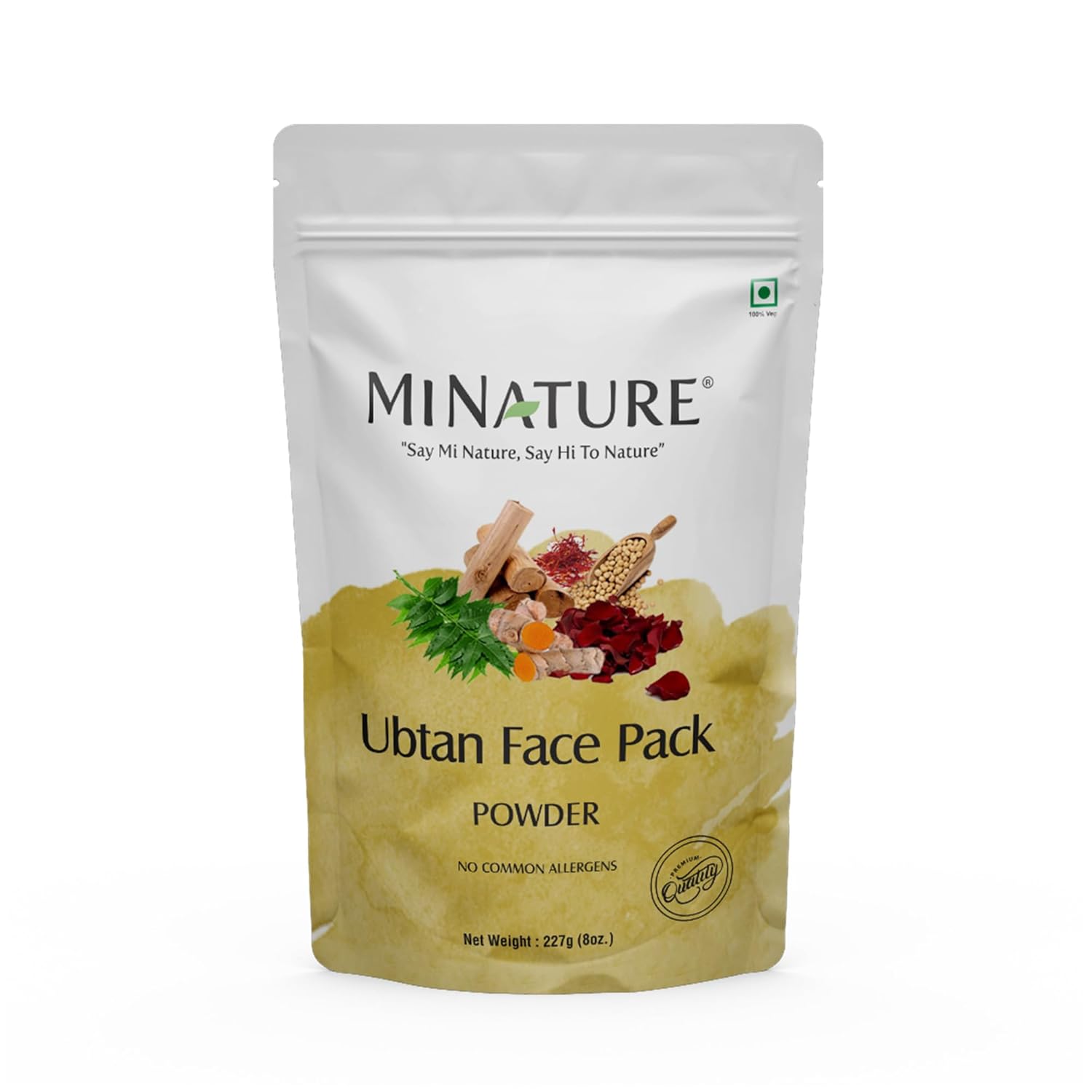
Anti Acne Blend Facial Ubtan
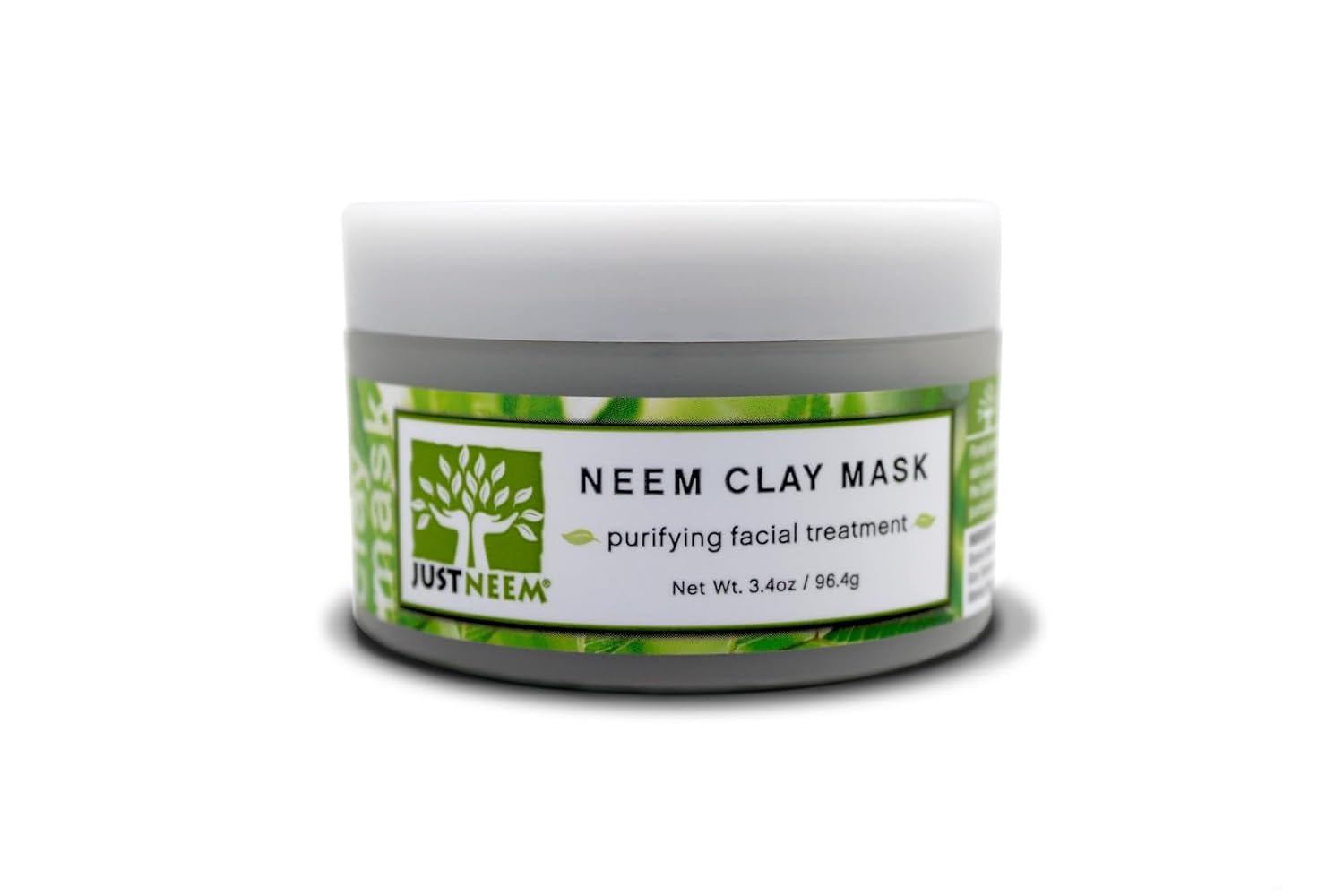
Neem Varnya Flawless Glow Face Mask
“Regular facial treatments can reduce the appearance of fine lines and wrinkles and promote tighter, firmer skin.”
Honey and Turmeric Anti-Inflammatory Mask
Discover the magic of turmeric and honey in this face mask. Turmeric is packed with curcuminoids, which fight inflammation and protect your skin. Honey, a natural germ fighter, works with turmeric to stop acne at its source.
Benefits of Turmeric in Skincare
Turmeric has been a skin savior for centuries. It’s full of curcumin, which helps with skin issues like psoriasis and eczema. It also reduces wrinkles and heals wounds.
Its anti-inflammatory powers soothe acne-prone skin. Plus, it fights off free radicals, lowering the risk of dark spots and skin cancer.
Step-by-Step Application Process
- In a small bowl, mix together 1/2 teaspoon of ground turmeric and 1 tablespoon of raw, unprocessed honey.
- Optionally, you can add a teaspoon of plain yogurt or milk to the mixture to help prevent turmeric from temporarily staining your skin.
- Cleanse your face and apply the honey-turmeric mask, avoiding the delicate eye area.
- Let the mask sit for 10-15 minutes, then rinse it off thoroughly with warm water.
- Gently pat your skin dry and follow up with your usual moisturizer.
Adding this anti-inflammatory mask to your skincare routine can make a big difference. Just remember to test it on a small area first to avoid any bad reactions.
Tea Tree and Clay Purifying Treatment
Struggling with oily skin and stubborn spot treatments? A homemade tea tree and clay face mask can change the game. This mix of tea tree oil and clay absorbs oil and purifies naturally, perfect for oily skin care.
To make this mask, mix 1-2 drops of pure tea tree essential oil with 15g of Aztec healing clay. Add 1 tablespoon (15ml) of witch hazel with alcohol. Stir until it’s smooth and spreadable. Use non-metal tools to keep the clay’s charge.
- Apply the mask evenly to clean, dry skin, avoiding the eye area.
- Let it sit for 10-15 minutes, or until it dries.
- Rinse with warm water and pat dry.
- Moisturize to hydrate and soothe your skin.
For bigger areas like the back or chest, double or triple the recipe. The mask might make your skin slightly red. But this is normal and temporary.
Tea tree oil and clay work together to clean and detoxify oily skin. Use this mask once or twice a week for best results.
| Ingredient | Quantity | Benefit |
|---|---|---|
| Aztec Healing Clay | 15g | Absorbs excess oil and removes impurities |
| Witch Hazel with Alcohol | 1 tbsp (15ml) | Provides astringent and toning properties |
| Tea Tree Essential Oil | 5-10 drops | Exhibits antibacterial and anti-inflammatory effects |
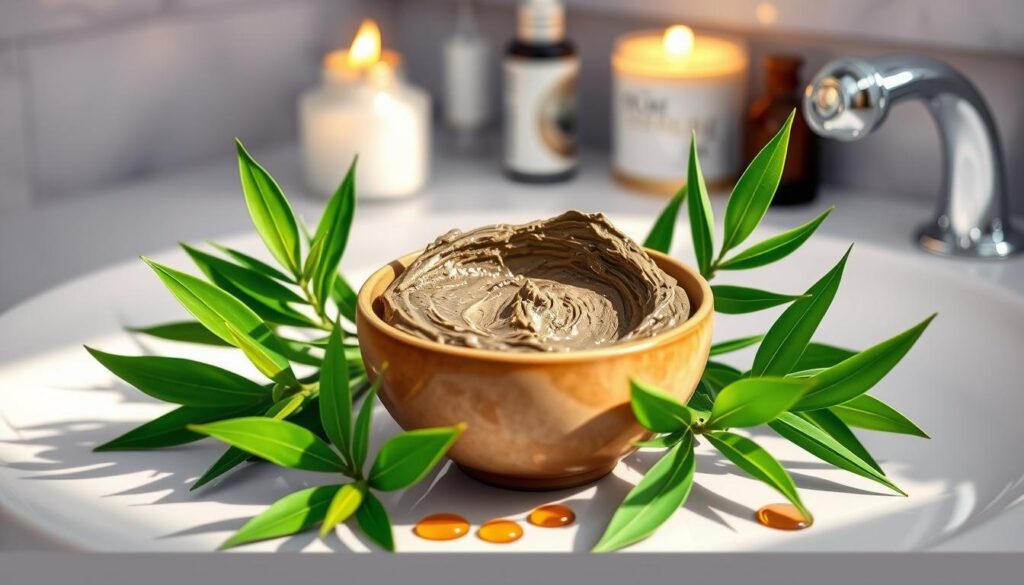
“Tea tree oil is a powerful natural ingredient that can help combat acne-prone and oily skin. When combined with the purifying properties of clay, it creates a potent yet gentle treatment for problematic complexions.”
Aloe Vera and Green Tea Soothing Mask
Aloe vera and green tea are a great team for natural acne masks and soothing skin treatments. Aloe vera helps oily, acne-prone skin by calming irritation and promoting healing. Green tea, with its antioxidants, controls oil and reduces inflammation, making the skin healthier and clearer.
Healing Properties of Aloe Vera
Aloe vera is known for its soothing and healing effects. It’s packed with vitamins, minerals, and enzymes that nourish and rejuvenate the skin. Its salicylic acid fights acne, and its anti-inflammatory properties soothe redness and irritation.
Green Tea’s Antioxidant Benefits
Green tea is full of antioxidants, like EGCG, which fight free radicals that cause breakouts and dull skin. Its anti-inflammatory properties also help calm the skin and control oil.
To make this soothing face mask, mix aloe vera gel and green tea powder. Apply it to clean, dry skin and leave it on for 15-20 minutes before rinsing. Drinking aloe vera juice can also nourish your skin from the inside and help with mild-to-moderate acne.
“Aloe vera and green tea are a dynamic duo, working together to soothe, hydrate, and purify the skin for a radiant, acne-free complexion.”
Oatmeal and Witch Hazel Calming Solution
Nature has a gentle yet effective solution for clear, healthy-looking skin – the Oatmeal and Witch Hazel Calming Solution. This homemade face mask uses oatmeal and witch hazel to soothe and rejuvenate skin. It tackles the root causes of home remedies for acne and offers a natural way to DIY face masks for acne.
Oatmeal and witch hazel are the main ingredients. Oatmeal is known for its anti-inflammatory properties and is rich in B vitamins, vitamin E, and minerals. When mixed with witch hazel’s astringent and antibacterial qualities, the mask removes excess oil, unclogs pores, and calms irritated skin.
To make this soothing mask, mix cooked, cooled oatmeal with a few drops of witch hazel. You can also add a couple of drops of tea tree oil or a pinch of turmeric powder for extra benefits. Apply the mask to your face, let it work for 20-30 minutes, then rinse with warm water.
| Ingredient | Benefit |
|---|---|
| Oatmeal | Anti-inflammatory, rich in B vitamins, vitamin E, and minerals |
| Witch Hazel | Astringent, antibacterial properties, removes excess oil |
| Tea Tree Oil | Antibacterial, anti-inflammatory properties |
| Turmeric | Antioxidant, anti-inflammatory, skin-brightening benefits |
The Oatmeal and Witch Hazel Calming Solution is great for those with acne-prone skin. It’s a natural, effective remedy. Try it in your skincare routine for a clearer, more radiant complexion.
Natural Ingredients to Avoid in Face Masks
When making homemade face masks for acne-prone skin, watch out for certain natural ingredients. They might seem good for fighting acne, but some can actually make your skin worse. This can lead to more breakouts.
Potential Irritants and Alternatives
Avoid lemon juice, apple cider vinegar, and baking soda. They are too acidic or alkaline and can upset your skin’s balance. This can cause dryness, inflammation, and more breakouts. Instead, choose gentler options like honey, aloe vera, and green tea. They are soothing and nourishing without the risk of irritation.
Signs of Skin Sensitivity
Watch for signs of skin sensitivity when trying new ingredients. Redness, itching, or a burning feeling mean it’s time to stop. Rinse your face with cool water right away. If you have sensitive skin or severe acne, talk to a dermatologist before trying new things.
Finding the right mix of acne-fighting ingredients and natural acne remedies is key to clear, healthy skin. Listen to your skin and be careful. This way, you can use nature’s power without causing irritation or breakouts.
“Homemade skin-care products can be great, but it’s important to do your research and consult with a dermatologist before trying new ingredients, if you have sensitive skin or severe acne.” – Mona Gohara, Connecticut-based dermatologist
Best Practices for Applying DIY Face Masks
Creating and using homemade face masks for acne requires the right application. Make sure all tools and containers are clean for hygiene. Apply the mask to clean skin, using gentle, upward strokes.
Let the mask sit for 10-20 minutes to let the ingredients work. Rinse with lukewarm water to remove all residue. Then, use a toner and moisturizer to keep your skin hydrated.
Use these natural face masks 1-2 times a week for best results. If your skin gets irritated, stop using it and see a dermatologist. Following these steps can help you get clear, healthy skin.
FAQ
What are the different types of acne breakouts?
Acne can be non-inflammatory, like whiteheads and blackheads. Or it can be inflammatory, with pustules, papules, cysts, and nodules.
What are the common triggers for acne formation?
Excess sebum, dead skin cells, and bacteria can cause acne. Hormones, diet, and stress also play a role.
How can natural remedies help with acne treatment?
Natural remedies can fight mild to moderate acne. They reduce inflammation, kill bacteria, and clear pores.
What are the key ingredients for DIY acne masks?
Key ingredients include honey, turmeric, and tea tree oil. Clay, witch hazel, aloe vera, green tea, and oatmeal are also important.
What are the benefits of homemade face masks for acne-prone skin?
DIY face masks are affordable and customizable. They’re good for the environment and can tackle specific acne issues.
How should you prepare and apply DIY face masks for acne?
Clean your face first. Do a patch test. Follow the mask’s application and removal instructions carefully.
What are the benefits of the honey and turmeric anti-inflammatory mask?
Turmeric fights inflammation. Honey is antibacterial, helping prevent future breakouts.
How does the tea tree and clay purifying treatment work?
Tea tree oil fights bacteria and inflammation. Clay absorbs oil and removes impurities.
What are the healing properties of the aloe vera and green tea soothing mask?
Aloe vera treats acne with salicylic acid and sulfur. Green tea controls oil and reduces inflammation with antioxidants.
How can the oatmeal and witch hazel calming solution help with acne?
Oatmeal is anti-inflammatory. Witch hazel removes oil and fights bacteria, addressing acne.
What natural ingredients should be avoided in face masks, and why?
Avoid lemon juice, apple cider vinegar, and cinnamon because they’re too acidic or can irritate. Turmeric might cause skin color changes.
How can you ensure proper application and use of DIY face masks for acne?
Use clean tools and apply to clean skin. Follow the mask’s instructions. Stop if you get irritated.

